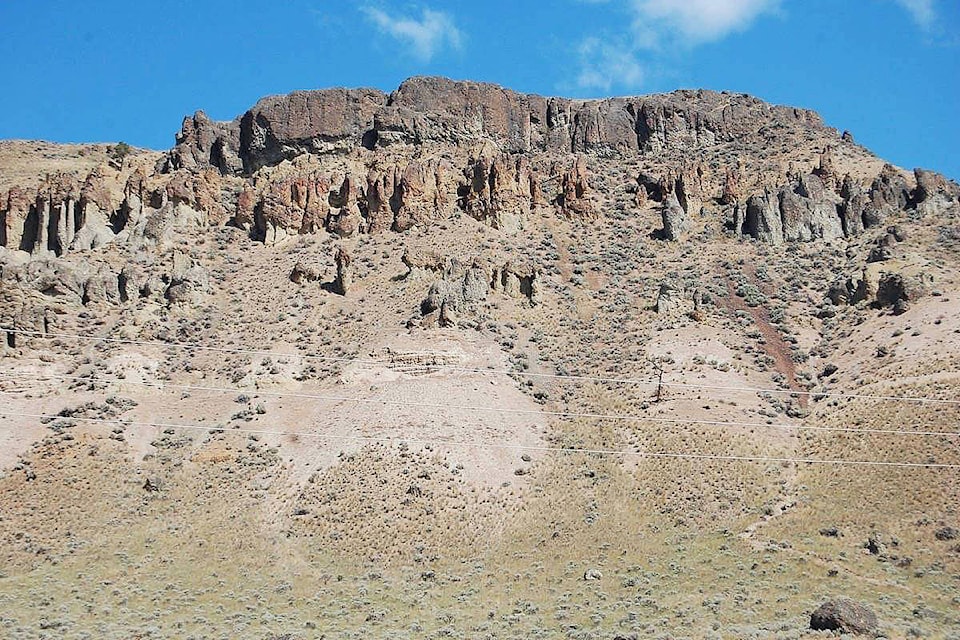After being closed for almost seven years, the McAbee Fossil Beds site has reopened to the public. The beds, which are 13km east of Cache Creek, contain a wealth of 53-million-year-old Eocene epoch fossils, and are also an important cultural and historic site for the Secwepemc people.
In July 2012 the provincial government declared McAbee a Heritage Site and closed it. In 2016 a group of volunteers began working to research ways of getting the site reopened and obtaining funding to allow that to happen.
On June 21 — Indigenous People’s Day across Canada — nearly 100 people gathered at the McAbee site to be part of the soft opening, which began with a traditional smudging ceremony. The Bonaparte Band’s Frank Antoine, chair of the board of the Thompson Okanagan Tourism Association (TOTA), explained the significance of the ceremony, adding “It’s always an honourable time when our people are recognized and take part in ceremonies like this. It keeps us strong.”
Deb Arnott of Community Futures Sun Country, who has been spearheading the drive to re-open McAbee, declared “We made it! It’s been a hell of a journey over the last three years.”
Former Bonaparte Band chief Ryan Day said “You can see a very, very long span of time at this place. It’s important to take an opportunity to contemplate time. What this place does is allow that.”
Randy Porter, the current Bonaparte chief, said “To have this come to fruition today is huge. In the last two years we’ve had fires and floods. To see the McAbee site developed is huge for our community, and I can see only good things after this point. It will be a success in the months to come.”
Steve Rice, TNRD director for Area “I”, spoke about the formation and history of the McAbee working group, noting the challenges the group faced after the 2017 wildfires. “A turning point came when Ryan Day said that the Bonaparte Indian Band wanted to be involved. The drum was beating so softly then, but it’s beating loud now.”
The Heritage Branch’s Elisabeth Deom spoke of the amazing fossils and the historical and cultural significance of the site, noting that protection of the site, science, and education are priorities, as is tourism.
“The work here has been done in a way of respect that acknowledges our stewardship role. It’s been an inclusive process, and I’m looking forward to the start of the next phase.”
Dr. Thomas Dickinson, the Dean of Science at Thompson Rivers University, said “We need to resurrect stories from the people here and from rocks that are 53 million years old.”
Amy Thacker, the CEO of Cariboo Chilcotin Coast Tourism Association, said that she was trying to imagine the area as a tropical lake 53 million years ago, and the flora and fauna that would have been there. “It’s hard to do. There have been a lot of changes over time. Now we’re here to celebrate this site.”
“Sustainable and respectful tourism is a focus,” said Ellen Walker-Matthews from TOTA. “It’s so important to the region.” Greg Hopf, also from TOTA, said that “To celebrate the soft opening of McAbee on Indigenous People’s Day is so fitting. The Bonaparte Indian Band and First Nations people will lead this project, not just be part of it.
“Non-First Nations groups have stepped aside and let us lead. That’s true and meaningful partnership. [McAbee] is a huge game-changer for the region, and will combine First Nations stories with history. We will transform visitors.”
Concluding the event, Antoine said “Everyone here is invested in this site, and I look forward to growing it together, and seeing people from around the world coming to visit us.”
The McAbee Fossil Beds Heritage Site is protected under the Province’s Heritage Conservation Act, and removing, disturbing, or destroying the fossils there is not permitted. The site will be open to the public for free guided tours from 10 a.m. to 5 p.m. Thursday through Monday during summer 2019. Future plans for the site include an interpretative centre, an ethnobotanical garden, a trails system with interpretive signs, viewpoints, and a research and storage facility for ongoing scientific research.
